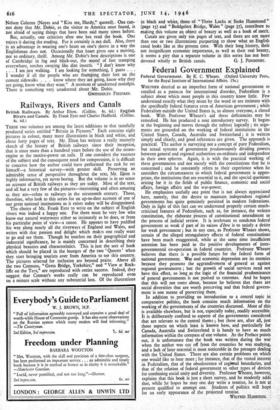Railways, Rivers and Canals
THESE two volumes are among the latest additions to that tastefully produced series entitled " Britain in Pictures." Each contains eight pictures in colour, many more illustrations in black and white, and about forty pages of text. Mr. Elton has written a really masterly sketch of the history of British railways since their inception, that is since more than a hundred years before the use of the steam- engine as the motive-power on rails. If one considers the vastness of the subject and the consequent need for compression, it is difficult to conceive how the author could have performed the task he set himself—a historical survey—with greater skill. Preserving an admirable sense of perspective throughout the text, Mr. Elton is highly informative, yet never boring. But the volume is in no sense an account of British railways as they are today. Most of the text, and all but a very few of the pictures—interesting and often amusing as they are—relate to railways in the nineteenth century. Those, therefore, who look to this series for an up-to-date account of one of our great national institutions as it exists today will be disappointed.
The choice of Mr. Frank Eyre to write on the subject of English rivers was indeed a happy one. For there must be very few who know our natural waterways either so intimately as he does, or from his particular point of view—a canoe. He appears to have paddled his way along nearly all the riverways of England and Wales, and writes with that passion and delight which makes one really want to go and• see them. Though he touches on their geographical and industrial significance, he is mainly concerned in describing their physical beauties and characteristics. This is just the sort of book which should be placed in the lounges of the two ' Queens ' when they start bringing tourists over from America to see this country. The pictures selected for inclusion are beyond praise. Above all the two Cotmans, " Greta Bridge, Yorkshire," and " View at Rock- liffe on the Tees," are reproduced with entire success. Indeed, they suggest that Cotman's works really can be reproduced even on a minute scale without any substantial loss. Of the illustrations in black and white, those of "Three Locks at Stoke Hammond" (page is) and "Beddgelert Bridge, Wales " (page 37), contribute to making this volume an object of beauty as well as a book of merit.
Canals are given only ten pages of text, and there are not more than one or two illustrations purporting to show what an English canal looks like at the present time. With their long. history, their not insignificant economic importance, as well as their real beauty, it seems a pity that a separate volume in this series has not been
devoted wholly to British canals. G. J. PONSONBY.






























 Previous page
Previous page